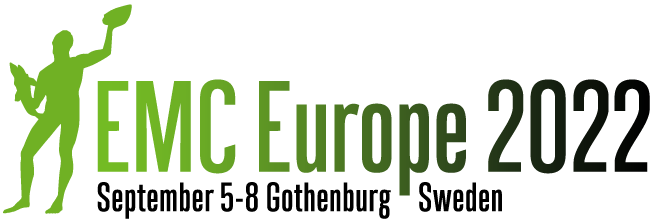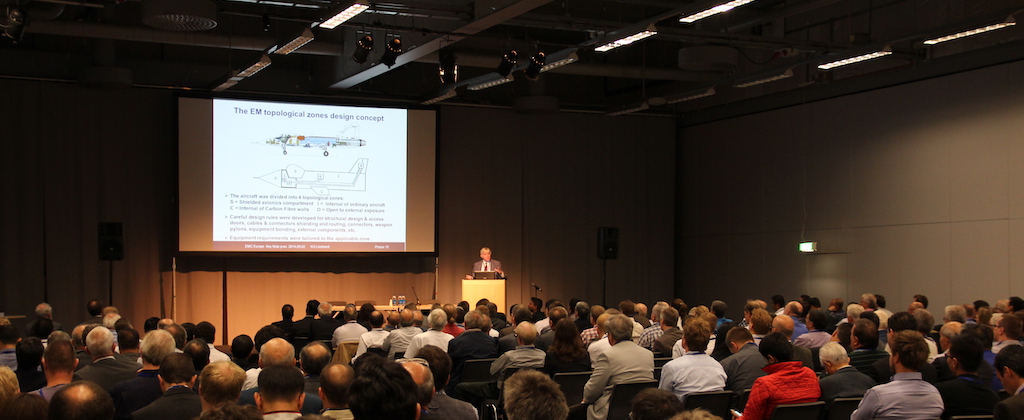Conducted EMI of an inverter-driven electric power train
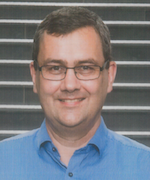
Dr. Robert Kebel
ABSTRACT: Due to the electrification in mobility applications, electric (high) power trains become an increasingly important subject of investigating EMI. This talk provides an overview about the systematic root cause of electromagnetic conducted emissions of a power train. Direct current (DC) power sources such as batteries or fuel cells provide the energy for propulsion. Alternating current (AC) electric engines drive the vehicle, because AC engines have advantages in maintenance and reliability. Pulse-width modulating (PWM) inverters convert DC into AC voltages. PWM technology can lead to significant electromagnetic interference (EMI) issues pending e.g. on power level and more electric parameters, which should be chosen early for mitigating the EMI risk. A simple predictive simulation model supports taking integration decisions in view of the EMI risk.
Typical power levels for smaller aircraft power trains start at 100 kW; levels up to some 10 MW are necessary for the propulsion of large transport aircraft. Fast switching inverters converting high power levels imply a high dV/dt and a significant EMI potential in common mode (CM). Besides filtering and shielding, a number of electric architecture decisions can mitigate EMI. This requires performing some basic predictive calculations
This talk will also show how the choice of the inverter and the choice of the power system (IT versus TN network) limits or exacerbates interference. Crosstalk to wiring looms routed adjacently to power train AC cables will further illustrate the effects and provide options for an optimization of a power train from an EMI point of view.
Robert Kebel was appointed Expert in EMC and lightning protection in 2008. He is leading industrial standardization in EMC and aviation (EUROCAE WG99/RTCA SC234 and WG58/SC202) and guided the first integration and certification of radio connectivity systems into the aircraft cabin. Since August 2001 Dr. Kebel is with Airbus in Hamburg, where he is in charge of electromagnetic compatibility and lightning protection. After his PhD in 1999 Dr. Kebel joined EADS Germany’s military aircraft section, where his responsibilities were in the field of signature technology. In 1997 he prepared an EMC test laboratories accreditation. From 1995 to 1998 he was research
assistant at the university’s institute for basic electromagnetics in Hanover and the German army’s university in Hamburg. During this period he also lectured transmission line theory at the Hanover University of Applied Sciences. In parallel he was working as a consultant in EMC design of electronics. Born in 1967 in Hanover, he studied electrical engineering at Hanover University where he graduated 1995 in control systems engineering and specialized in electromagnetic compatibility. He is author of numerous publications in the field of electromagnetic compatibility and lightning protection. Dr. Kebel is an IEEE senior member and distinguished lecturer of the IEEE EMC society. He also is associate editor of the IEEE Letters on Electromagnetic Compatibility Practice and Applications.
.
Radiofrequency fields from mobile phone technologies and health
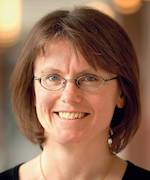
Maria Feychting, professor of epidemiology
ABSTRACT: The introduction of handheld mobile phones in the late 1980s has increased the exposure to radiofrequency fields (RF) in the general population. With each new generation of mobile phone technology, RF exposure levels from mobile phone handsets have become lower, and environmental levels from base stations only a fraction of that from handsets. Deployment of 5G at frequency levels used by older technologies is not expected to change this pattern, although exposure levels need to be continuously monitored as the technology develops. Each new generation of wireless technology has led to concern about potential health effects, and 5G is no exception. Most attention has been given to potential cancer risks and to health outcomes such as unspecific symptoms reported by persons who perceive themselves as hypersensitive to electromagnetic fields. Overall, scientific research has not found support for a causal link between radiofrequency fields and the unspecific symptoms reported. For cancer outcomes, the evidence of an increased risk is also weak; however, in 2011 the International Agency for Research on Cancer (IARC) classified radiofrequency electromagnetic fields as possibly carcinogenic, mainly based on findings in a few epidemiological case-control studies on mobile phone use and brain tumor risk. Although time trend studies saw no increase in the occurrence of these tumors despite a considerable increase in the prevalence of RF exposure over a short time period, the IARC working group believed these studies covered a too short time period to be informative. Since the IARC evaluation, additional case-control studies and prospective cohort studies have been published, as well as a considerable number of incidence time trend studies from different countries, covering a much longer time period. For 5G at frequency levels similar to earlier mobile phone generations, health risk assessment can learn from comprehensive research conducted over the past decades, whereas for higher frequency ranges, such as 26 GHz, fewer data are available. This presentation will summarize the evidence from epidemiological studies available to date.
Maria Feychting is Professor of Epidemiology at Karolinska Institutet, Institute of Environmental Medicine, and Head of the Unit of Epidemiology. Her research is focused on risk factors for chronic diseases, primarily cancer but also other chronic diseases. She has a specific interest in childhood cancer and adult brain tumors, both in terms of risk factors such as environmental and genetic factors. She has conducted research on potential health effects of non-ionizing radiation since the late 1980s, and she is the PI for the Swedish parts of the Interphone study, the Cefalo study, the Sotan study and the COSMOS study. She has published over 300 original articles, brief communications, review articles, editorials, letters, and book chapters, with ~ 250 listed in PubMed, and a WoS h-index of 59. She participates in the work of the WHO EMF programme and has been invited expert in several national and international health risk assessment expert groups. She was member of the International Commission on Non-Ionizing Radiation Protection (ICNIRP) during 2008 to 2020 and vice chairman 2012-2020. ICNIRP is an independent body suggesting science-based guidelines for non-ionizing radiation protection, which are used by many countries.
.
The Quest for Fundamentally New SI-Traceable Measurement Techniques and the Development of New Sensing Capabilities
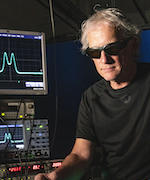
Dr. Christopher Holloway
ABSTRACT: The quest of Christopher Holloway to understand and develop fundamentally new measurement methods started when he was perusing his undergraduate degree and continues to this day.
One of the keys to developing new science and technologies is to have sound metrology tools (i.e., measurement tools) and techniques. A stated goal of international metrology organizations, including the National Institute of Standards and Technology (NIST), is to make all measurements traceable to the International System of Units (SI). The world of measurement science is changing rapidly with the SI redefinition that occurred in 2018. As a result of the shift towards fundamental physical constants, the role of primary standards and measurements must change. Atom-based measurements allow for direct SI-traceable measurements, and as a result, measurement standards have evolved towards atom-based measurements over the last few decades; most notably length (m), frequency (Hz), and time (s) standards. Recently, there has been a great interest in extending this to magnetic and electric (E) field sensors. Fundamental to all electromagnetic/communication measurements is having accurately calibrated probes, antennas, and power meters in order to measure either electric (E) fields or power.
In the past 10 years, we have made great progress in the development of a fundamentally new direct SI-traceable approach based on Rydberg atoms (traceable through Planck’s constant, which is now an SI defined constant). The Rydberg atom-based sensors now have the capability of measuring amplitude, polarization, and phase of the RF field. As such, various applications are beginning to emerge. These include SI-traceable E-field probes, power-sensors, voltage standards, receivers for communication signals (AM/FM modulated and digital phase modulation signals), and even the recording of musical instruments. In fact, this new atom-based technology has allowed for interesting and unforeseen applications. These new Rydberg atom-based sensors will be beneficial for 5G and beyond in that they will allow for the calibrations of both field strength and power for frequencies above 100 GHz. In this talk, I will lead us on a historical journey of the development of this approach, and in the process, I will summarize this work and discuss various applications.
In this talk, I will also introduce the National Institute of Standards and Technologies (NIST) and discuss what NIST does and discuss why international measurement standards are important.
Dr. Christopher Holloway is a Fellow of the IEEE and has been at NIST for over 25 years. He is also on the Graduate Faculty at the University of Colorado at Boulder. He received his B.S.E degree from the University of Tennessee, and his Master and PhD degrees from the University of Colorado at Boulder. His is an expert in electromagnetic theory and metrology, quantum-optics, Rydberg-atom systems, and atom-based sensors. He has a publication h-index of 57 with over 300 technical publications (including 143 refereed journal papers and 130 conference papers) and has over 12,000 citations of his papers. He also has 10 patents in various fields in engineering and physics. He is the Project Leader for the Rydberg-Atom-Sensor Project and is the Group Leader for the Electromagnetic Fields Group.
